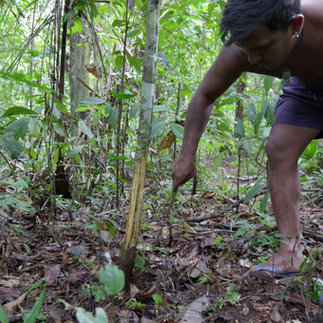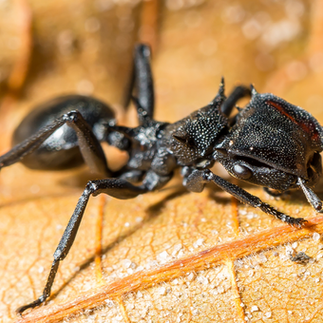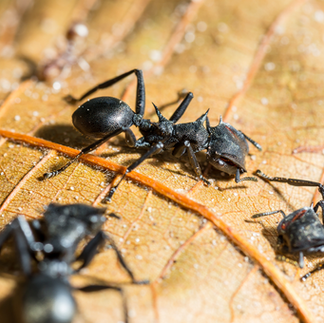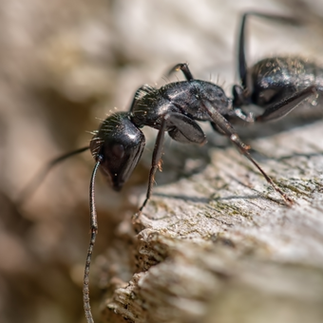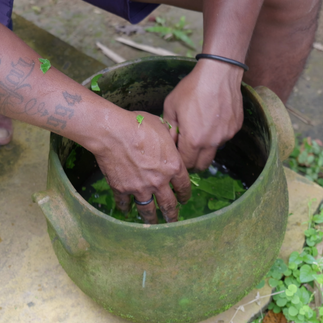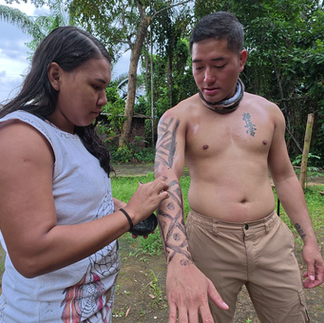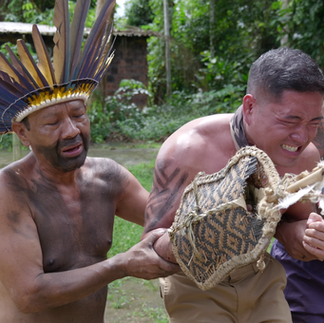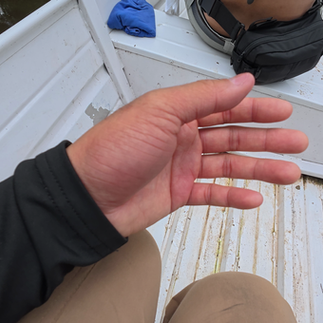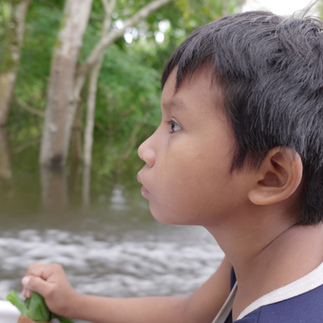The Bullet Ant Gloves - Surviving the World's Most Painful Ritual
- Ser Andy
- Jul 15
- 7 min read
Updated: Jul 15
From Dream to Reality
I recently fulfilled a lifelong dream: participating in the the most painful ritual in the world, the infamous Bullet Ant Initiation ritual with the Sateré-Mawé tribe deep in the Amazon rainforest near Manaus, Brazil. I had dreamt of this since I was teenager (I know. This sounds crazy!) and it finally became real.

Into the Jungle
From Manaus, a thriving metropolis of over 2 million people in the middle of the Amazon jungle, we drove two hours and then rode a motorized canoe to reach the tribe’s remote riverside village. The Sateré-Mawé chief and a young man came to receive us and guided us into their mysterious world. To be honest, I felt quite special that the chief himself came to take us in. What a honor!

The Sateré-Mawé Tribe
The Sateré-Mawé are an Indigenous people of the Brazilian Amazon, living primarily along the Andirá and Marau rivers in the state of Amazonas. They are best known for their bullet ant initiation ritual, but their culture extends far beyond this rite of passage.
The Sateré-Mawé are the original domesticators of guaraná, a powerful natural stimulant now popular worldwide, which they still cultivate using traditional methods. Their society is organized into clans, with strong spiritual beliefs, shamanic practices, and a deep connection to the forest that sustains them. Despite increasing outside pressures, the Sateré-Mawé continue to preserve their language, land, and customs with resilience and pride.
Hunting Bullet Ants
We returned to the river and journeyed 25 to 30 minutes upstream, navigating deeper into the jungle in search of the infamous bullet ants (Paraponera clavata) — feared for having the most excruciating sting in the insect world. After several failed attempts and false starts, we finally discovered a nest tucked beneath the roots of a tree.
The ants were enormous — nearly 3 centimeters long, jet-black, and absolutely intimidating. A young Sateré-Mawé tribesman stirred the nest with a stick, then blew cigarette smoke into the entrance to agitate them. Believing there was a fire, the ants began evacuating — even carrying their eggs to safety.
Using a length of hollow bamboo, the young man fashioned a makeshift container. He gathered a small bundle of palm fronds, tied them tightly, and created a natural stopper to keep the ants from escaping once inside.
Over the next 45 minutes, we managed to collect around 50 ants. Judging by the number still crawling in and out of the nest, there were likely over a hundred living beneath that tree.
Scientific Facts: The Bullet Ant
Scientific Name: Paraponera Clavata
Length: 2.5–3 cm
Habitat: Amazon rainforest
Venom: Contains poneratoxin, a neurotoxin that disrupts nerve and muscle signaling.
Pain Index: 4.0+ (Schmidt Index) – described as “pure, intense, brilliant pain…like walking over flaming charcoal with a 3-inch nail embedded in your heel.”
Preparing the Ritual
Back in the village, the bullet ants were submerged in a cashew leaf (Anacardium Occidentale) infusion — a traditional method used to calm and sedate them. This species of leaf is native to northeastern Brazil but is widespread throughout the Amazon and tropical regions. In traditional Amazonian medicine, cashew leaves are used for their anti-inflammatory, sedative, and antimicrobial properties — which likely explains their role in calming the bullet ants during the glove ritual.
After about 15 minutes, they were gently inserted one by one, head facing outward, into a handwoven bamboo glove that had been soaked in water to soften the fibers. Each ant's stinger was carefully positioned to point inward — awaiting the hand that would enter.
Before the ritual began, our arms and torsos were painted with black charcoal, a symbolic act of preparation. The chief emerged, now adorned in a vibrant feathered headdress, his chest painted dark with sacred pigment (aka charcoal). He performed a ceremonial blessing — calling on the spirits to protect our hands and grant strength to our lives.
At the end of the ritual, he gave us names in the Sateré-Mawé language — a powerful rite of inclusion. Mine was Verdade, meaning Truth. My brother was named Jaguar — a symbol of strength, fearlessness, and respect.
The Sting – Like Fire Piercing Your Soul
I clenched my teeth, tightened my fingers, and braced for the unknown. My left hand went in first. The instant it touched the inside of the glove, pain exploded — as if searing hot metal rods were being driven straight through my skin, deep into every nerve.
I tried to hold back a scream. I failed. It wasn’t just pain — it was a violation of the senses.
My mind went white. I could feel it not only in my hand, but in my skull — a blinding, pressure-loaded migraine that radiated into thought itself. My body trembled, my breath staggered. It was unlike anything I’ve ever endured. It was beyond pain. It was primal.
After two and a half minutes of unrelenting agony, the chief turned to me and asked, calmly, if I wanted to do the other hand. I looked at him in disbelief — but how could I say no?(Originally, they had only prepared one glove — the plan was for me to go first, then my brother. But in that moment, something else took over. Spirit, pride… or madness.)
I slipped my right hand into the glove. And it was no different — searing, burning, pulsing electricity surged through every fiber of my being. But now, it felt deeper. Not just physical, but spiritual. As if I wasn’t just enduring the pain — I was becoming a part of it. A part of the ant. A part of the forest.
My body began to convulse. My lips foamed. I could no longer control my movements. My eyes squeezed shut, flashes of white light bursting behind the lids. Somewhere in the distance, I could hear people gasping, chanting — or maybe it was just in my head.
All I knew was: I needed to get my hands out of those gloves. Now.
The Aftermath
The ritual was over. But I wasn’t. I dropped to my knees — shaking, breathless, locked in a storm of pain and disbelief. My hands had become monstrous things, swollen and twitching with a pulse of their own. My chest tightened. My vision blurred. My thoughts turned to white noise. I tried to wiggle my fingers — nothing. They weren’t numb… they were gone. The pain had begun to crawl up my forearms, gripping my muscles like fire wrapped in barbed wire.
There was no more control. No more pretending to be strong. My hands hung like dead weight. Useless. Unresponsive. And despite having pulled them out of the gloves, it felt as though the true pain — the deep pain — was only just beginning. Like the ants had left behind a spirit… or a curse… that was now awakening inside my veins.
The chief approached me, gently. Calmly. He placed a hand on my shoulder and told me I was a warrior — a hero — for taking part in the ritual. I dug deep into myself, pushed through the fog, and whispered my thanks. I told him, with all sincerity, how much more respect I had now for him, his tribe, and the strength of his people.
Shortly after, we boarded the same small boat to leave the village. I sat hunched over in silence, hands burning hotter now, as if the pain had started boiling inside my bones. It moved past my wrists and elbows, inching toward my chest — like it was trying to reach my heart.
By the time we got to the car, we still had a two-hour drive ahead back to Manaus. And that’s when the emotional shift hit me. I wasn’t just in pain anymore. I was angry. Violently angry. Something primal was surfacing. I remember hearing my brother Tonny and our driver talking in the front seat — casual conversation — but to me, it felt like nails in my ears. Rage boiled inside me. I didn’t want to hear anything. I wanted silence. I wanted to scream. I wanted to fight. My chest felt like it was going to burst open.
But instead of yelling, I breathed deep, clenched my jaw, and calmly asked Tonny, “Bro… could we just stay quiet for a little while? Until we get to the hotel.” He understood instantly.
Once we arrived, I went straight to my room and collapsed into bed. But sleep never came. I just lay there in the dark — twisted in pain, sweat-soaked, and waiting for it to end. But it didn’t.
The pain held on for over 10 hours — waves of fire and numbness alternating like tides. Even after 24 hours, the aftershocks and swelling were still there.
My brother, Tonny endured the same. He only put one hand in — the other he kept free to film. But the suffering? It didn’t discriminate. One hand was enough to experience the jungle’s wrath.
The Rite of Manhood
Among the Sateré-Mawé, this glove ritual is more than a test of endurance — it is a sacred rite of passage. Young boys must undergo the ceremony at least 20 times throughout their lives in order to be recognized as true warriors of the tribe. But this tradition isn’t reserved for males alone — girls, too, participate in the ritual, proving their resilience and spirit in the same fire. For the Sateré-Mawé, it’s not merely about pain. It’s about discipline, dignity, and the forging of character through suffering. It is a spiritual gateway — one that binds a person not only to their community, but to the forest itself.
Final Thoughts
We believe we are the first Vietnamese individuals — and perhaps the first Vietnamese YouTubers — to ever take part in this sacred ritual of the Sateré-Mawé. Of course, I could be wrong. And if there are others out there — other Vietnamese brothers or sisters who have endured this rite — I would be honored to speak with them, to share stories and learn from their journey.
For me, what began as a childhood fascination with tribal cultures and ancient rites has transformed into something far greater: a life-defining moment marked by pain, humility, and profound respect. This was not just a challenge for content. This was a ceremony rooted in centuries of identity, resilience, and connection with the natural world.
To be welcomed into that space — even briefly — by the Sateré-Mawé, and to be given a tribal name, was a gift I will carry with me for the rest of my life. This experience has changed how I view strength. Not as domination, but as presence. Not as muscle, but as meaning. In that forest, with my hands burning and my body trembling, I came face to face with a form of spiritual courage I had never known.
I walked away a different man.







